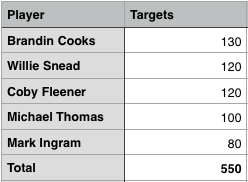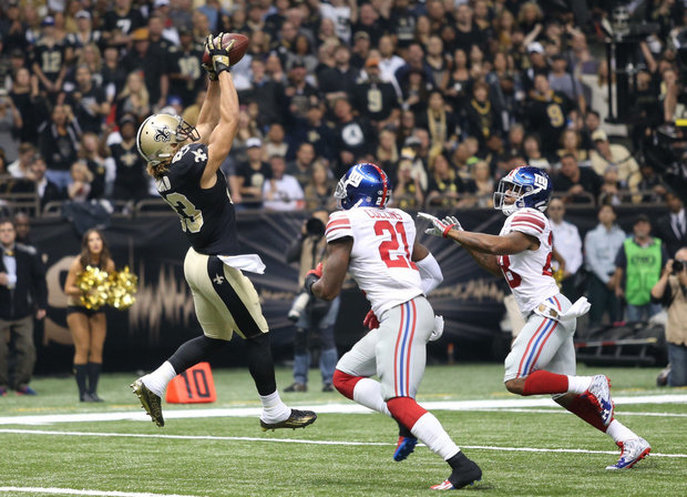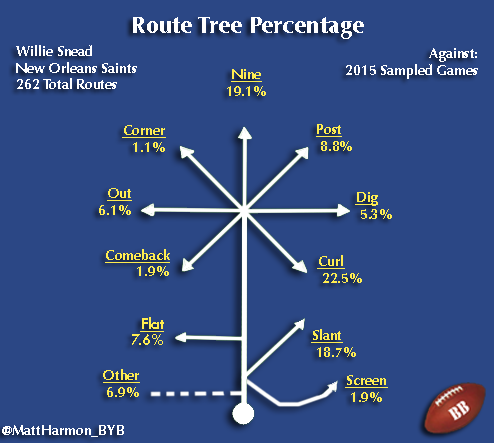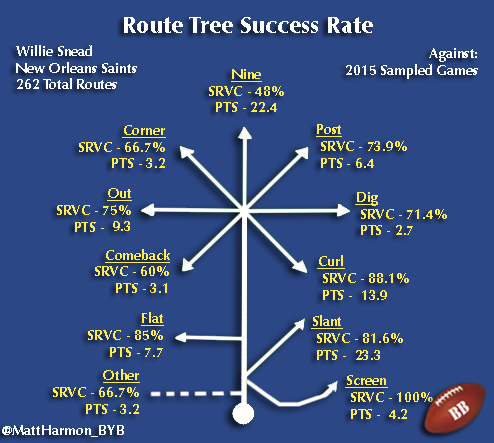Reception Perception: Willie Snead built an impressive resume we must not ignore
By: Matt Harmon
June 27th,2016
June 27th,2016
It's quiet, too quiet. Almost any time a second-year wide receiver in his age 22 to 23-year old season nearly cracks 1,000 yards a good amount of hype follows. This is especially the case when the wideout is attached to one of the NFL’s best passers.
Yet, for whatever reason, Willie Snead seems immune to receiving such due credit. Snead’s early days in the NFL weren’t glamorous coming from the ranks of the undrafted in 2014. After curiously not getting a spot with the Cleveland Browns, despite some buzz out of training camp, he spent some time on the Carolina Panthers practice squad. He didn’t last there and eventually finished the year on the New Orleans Saints own practice unit. The young receiver quickly climbed the depth chart in his first full offseason with the Saints and became a starter in his second season. He finished his first year on an active roster with 69 receptions for 984 yards and 3 touchdowns in just 15 games.
On the surface that should be the resume of a player the football cognoscente (h/t Chris Wessling) has high hopes for. When you consider that Snead followed up his 2012 season (89-1,148-9) at Ball State by breaking school records in his final year (106-1,516-15), it becomes even more clear this player has a fighting chance to stick in the NFL.
Perhaps it’s Snead’s severe lack of athleticism and draft pedigree that still clouds the public’s mind to this day. Despite his heroic rise to prominence with the Saints Snead checks in as the 115th overall player taken in dynasty startups as the WR55, per RotoViz ADP.
The public must view Willie Snead’s 2015 season as a mere flash in the pan, something not to be taken seriously. They can point to the additions of Coby Fleener at tight end and Ohio State wideout Michael Thomas in the second-round as evidence the team agrees. As is always the case with these set of circumstances, we must remove noise from the equation and revisit the reality of what took place on the field. After doing so, we can properly assign credit for the surprising season of Willie Snead.
When Snead began his emergence early in the year it was apparent his reliability and versatility were like catnip for Drew Brees. Another undrafted utility-man, Lance Moore finished with at least eight touchdowns or 1,000 yards in four of five seasons in New Orleans from 2008 to 2012. Sigmund Bloom asserted that Willie Snead struck him as a “souped-up version of Moore”.
In the eight games sampled for Reception Perception Snead lined up in the slot on 24.8 percent of his snaps. He split time between the left (32 percent) and right (43 percent) wide receiver positions. In a brief early-season, look Reception Perception noted that Snead recorded a catch on every route on the tree, excluding the screen, against the Cowboys and Eagles. At that point in the season, Snead was outplaying Brandin Cooks who struggled to win against press coverage as the clear No. 1 receiver.
When a team’s hopeful star falters it often paves the way for a more nuanced and consistent, albeit less flashy, option to emerge. Willie Snead certainly fits that mold as a detailed technician at the craft of route-running.
Yet, for whatever reason, Willie Snead seems immune to receiving such due credit. Snead’s early days in the NFL weren’t glamorous coming from the ranks of the undrafted in 2014. After curiously not getting a spot with the Cleveland Browns, despite some buzz out of training camp, he spent some time on the Carolina Panthers practice squad. He didn’t last there and eventually finished the year on the New Orleans Saints own practice unit. The young receiver quickly climbed the depth chart in his first full offseason with the Saints and became a starter in his second season. He finished his first year on an active roster with 69 receptions for 984 yards and 3 touchdowns in just 15 games.
On the surface that should be the resume of a player the football cognoscente (h/t Chris Wessling) has high hopes for. When you consider that Snead followed up his 2012 season (89-1,148-9) at Ball State by breaking school records in his final year (106-1,516-15), it becomes even more clear this player has a fighting chance to stick in the NFL.
Perhaps it’s Snead’s severe lack of athleticism and draft pedigree that still clouds the public’s mind to this day. Despite his heroic rise to prominence with the Saints Snead checks in as the 115th overall player taken in dynasty startups as the WR55, per RotoViz ADP.
The public must view Willie Snead’s 2015 season as a mere flash in the pan, something not to be taken seriously. They can point to the additions of Coby Fleener at tight end and Ohio State wideout Michael Thomas in the second-round as evidence the team agrees. As is always the case with these set of circumstances, we must remove noise from the equation and revisit the reality of what took place on the field. After doing so, we can properly assign credit for the surprising season of Willie Snead.
When Snead began his emergence early in the year it was apparent his reliability and versatility were like catnip for Drew Brees. Another undrafted utility-man, Lance Moore finished with at least eight touchdowns or 1,000 yards in four of five seasons in New Orleans from 2008 to 2012. Sigmund Bloom asserted that Willie Snead struck him as a “souped-up version of Moore”.
In the eight games sampled for Reception Perception Snead lined up in the slot on 24.8 percent of his snaps. He split time between the left (32 percent) and right (43 percent) wide receiver positions. In a brief early-season, look Reception Perception noted that Snead recorded a catch on every route on the tree, excluding the screen, against the Cowboys and Eagles. At that point in the season, Snead was outplaying Brandin Cooks who struggled to win against press coverage as the clear No. 1 receiver.
When a team’s hopeful star falters it often paves the way for a more nuanced and consistent, albeit less flashy, option to emerge. Willie Snead certainly fits that mold as a detailed technician at the craft of route-running.
With Cooks owning the role of the vertical threat and Ben Watson shocking the world at tight end, Snead slid into the chain-moving possession receiver spot. As such, it’s no surprise we see the curl and slant route take up the majority of his route portfolio and the nine route check in at a below average 19.1 percent. On any given play, if the first read is unable to work open, Brees can count on Snead as a reliable dump-off option. However, there’s more to his game than that.
Snead’s out and flat route percentage are also represented at an above average rate in relation to other sampled NFL receivers. This shows that Snead can function as an outside boundary threat, not just an interior or ancillary player.
Again we seem to arrive at the Bloom-created notion of Willie Snead as a “souped-up” possession receiver. When studying which routes Snead is most successful on, we stroll further down the path to that conclusion.
Snead’s out and flat route percentage are also represented at an above average rate in relation to other sampled NFL receivers. This shows that Snead can function as an outside boundary threat, not just an interior or ancillary player.
Again we seem to arrive at the Bloom-created notion of Willie Snead as a “souped-up” possession receiver. When studying which routes Snead is most successful on, we stroll further down the path to that conclusion.
We noticed that the flat, slant and curl route were Snead’s most commonly run routes in this Reception Perception sample. It’s tremendous to see they also come with his best Success Rate Vs. Coverage (SRVC) scores. His ability to flash open on flat and slant routes fit in perfectly with the quick-strike nature of the New Orleans passing offense.
To put into context just how impressive Snead’s 88.1 percent SRVC on curl routes is, the undrafted wideout falls below only 2014 scores Andre Johnson (88.5) and Michael Crabtree (93.9) in this metric during Reception Perception history. Crabtree’s example, in particular, is important for Snead.
By 2014, injuries had largely sapped Crabtree of most of his athletic gifts. However, his Reception Perception showed that he was still a strong route-runner capable of succeeding without those gifts. He went on to prove that in Oakland after getting a quarterback upgrade. Other players that fit this mold on curls like Steve Johnson (87.1 SRVC), Jarvis Landry (84.6 SRVC and even Antonio Brown (81.3 SRVC) demonstrate the archetype that Snead should hope to walk down. These receivers lacked greatly in measured athleticism prior to entering the league. Yet, all carved out varying levels of success in their careers due to their tremendous proficiency at the craft of route-running.
Elsewhere on the route tree, Snead only scored below the league average on comebacks, curls and nine routes. His out SRVC score is another indication of his strong sense of timing and ability to create separation at the break points in routes.
Willie Snead’s 48-percent SRVC score on nine routes demonstrates the reality that his lack of tremendous athletic ability will always keep him from being a great deep threat. However, his 22.4 PTS recorded on nines and his quite strong 73.9 percent SRVC on posts show that he can get vertical on occasion. That’s another important factor in the Saints offense. While Brees is primarily a timing and execution-based quarterback, he does not shy away from the deep ball.
When viewing Snead’s SRVC scores in totality, we begin to contextualize just how impressive his debut season was.
To put into context just how impressive Snead’s 88.1 percent SRVC on curl routes is, the undrafted wideout falls below only 2014 scores Andre Johnson (88.5) and Michael Crabtree (93.9) in this metric during Reception Perception history. Crabtree’s example, in particular, is important for Snead.
By 2014, injuries had largely sapped Crabtree of most of his athletic gifts. However, his Reception Perception showed that he was still a strong route-runner capable of succeeding without those gifts. He went on to prove that in Oakland after getting a quarterback upgrade. Other players that fit this mold on curls like Steve Johnson (87.1 SRVC), Jarvis Landry (84.6 SRVC and even Antonio Brown (81.3 SRVC) demonstrate the archetype that Snead should hope to walk down. These receivers lacked greatly in measured athleticism prior to entering the league. Yet, all carved out varying levels of success in their careers due to their tremendous proficiency at the craft of route-running.
Elsewhere on the route tree, Snead only scored below the league average on comebacks, curls and nine routes. His out SRVC score is another indication of his strong sense of timing and ability to create separation at the break points in routes.
Willie Snead’s 48-percent SRVC score on nine routes demonstrates the reality that his lack of tremendous athletic ability will always keep him from being a great deep threat. However, his 22.4 PTS recorded on nines and his quite strong 73.9 percent SRVC on posts show that he can get vertical on occasion. That’s another important factor in the Saints offense. While Brees is primarily a timing and execution-based quarterback, he does not shy away from the deep ball.
When viewing Snead’s SRVC scores in totality, we begin to contextualize just how impressive his debut season was.
Snead posted well above average SRVC scores when facing man, zone and press defenses. Sean Payton described Snead as a player who “has a real good knack for finding the right holes in zone” and getting open with “leverage in man-to-man.” Reception Perception quantifies the crafty proficiency of Snead that his head coach described. His raw scores against all forms of coverage came off quite similar to Randall Cobb’s tremendous 2014 season.
Payton also believes “we can see a big step” from Snead after one year in the system. All indications are he will continue holding an important role in the New Orleans offense. Drew Brees pushes 650 pass attempts on an annual basis. A rough projection of the Saints most prominent pass-catchers shows there’s more than enough room for everyone to get work.
Payton also believes “we can see a big step” from Snead after one year in the system. All indications are he will continue holding an important role in the New Orleans offense. Drew Brees pushes 650 pass attempts on an annual basis. A rough projection of the Saints most prominent pass-catchers shows there’s more than enough room for everyone to get work.
 Rudimentary Saints target projections
Rudimentary Saints target projections
If anything, Willie Snead has the clearest role out of any non-Cooks player. Michael Thomas and Coby Fleener should both split-out to run routes from the slot and win in the middle of the field. There’s some danger in the two of them canceling each other out at times. Both will play bigger roles in the red zone, where Snead might not excel with a mere 44.4 percent contested catch conversion rate. However, he looks entrenched as the reliable, underneath possession receiver. In this offense with a perfect fit at quarterback, that’s a high-value role. It feels foolish to put artificial limitations on Willie Snead’s outlook given his play and all the variables at hand.
Everyone has long been in search for “the next Antonio Brown” after the Steelers receiver rose up from the sixth-round to All-Pro form. Tyler Lockett is a popular guess, but that feels too easy given his far superior measured athleticism and draft pedigree. Way back in November 2015, I was a guest on RotoViz radio where co-host Matthew Freedman pointed out that Snead’s early NFL resume in conjunction with athletic and college production profile looked strikingly similar to Brown circa 2011.
It would be bullish and aggressive to assert that Willie Snead will definitely follow Brown down the rest of that path to become one of the NFL’s best receivers. However, Freedman’s observation integrated with Snead’s Reception Perception results indicate that we certainly do have a tremendously real sleeper on out hands. His resume so far suggests we should continue to expect big outputs from Willie Snead.
Everyone has long been in search for “the next Antonio Brown” after the Steelers receiver rose up from the sixth-round to All-Pro form. Tyler Lockett is a popular guess, but that feels too easy given his far superior measured athleticism and draft pedigree. Way back in November 2015, I was a guest on RotoViz radio where co-host Matthew Freedman pointed out that Snead’s early NFL resume in conjunction with athletic and college production profile looked strikingly similar to Brown circa 2011.
It would be bullish and aggressive to assert that Willie Snead will definitely follow Brown down the rest of that path to become one of the NFL’s best receivers. However, Freedman’s observation integrated with Snead’s Reception Perception results indicate that we certainly do have a tremendously real sleeper on out hands. His resume so far suggests we should continue to expect big outputs from Willie Snead.
Comment Form is loading comments...




